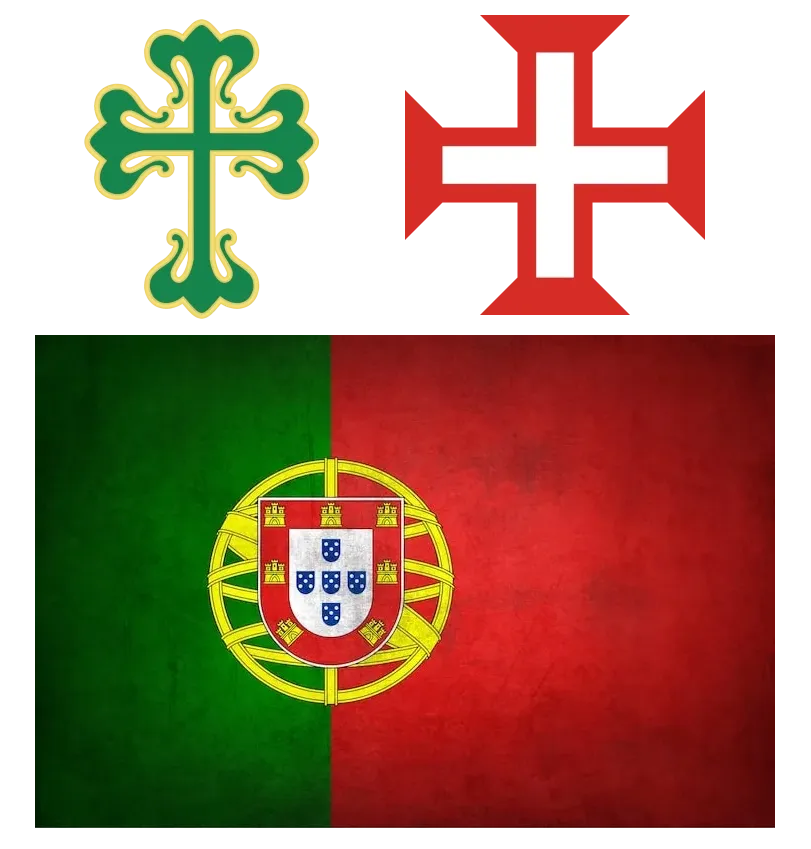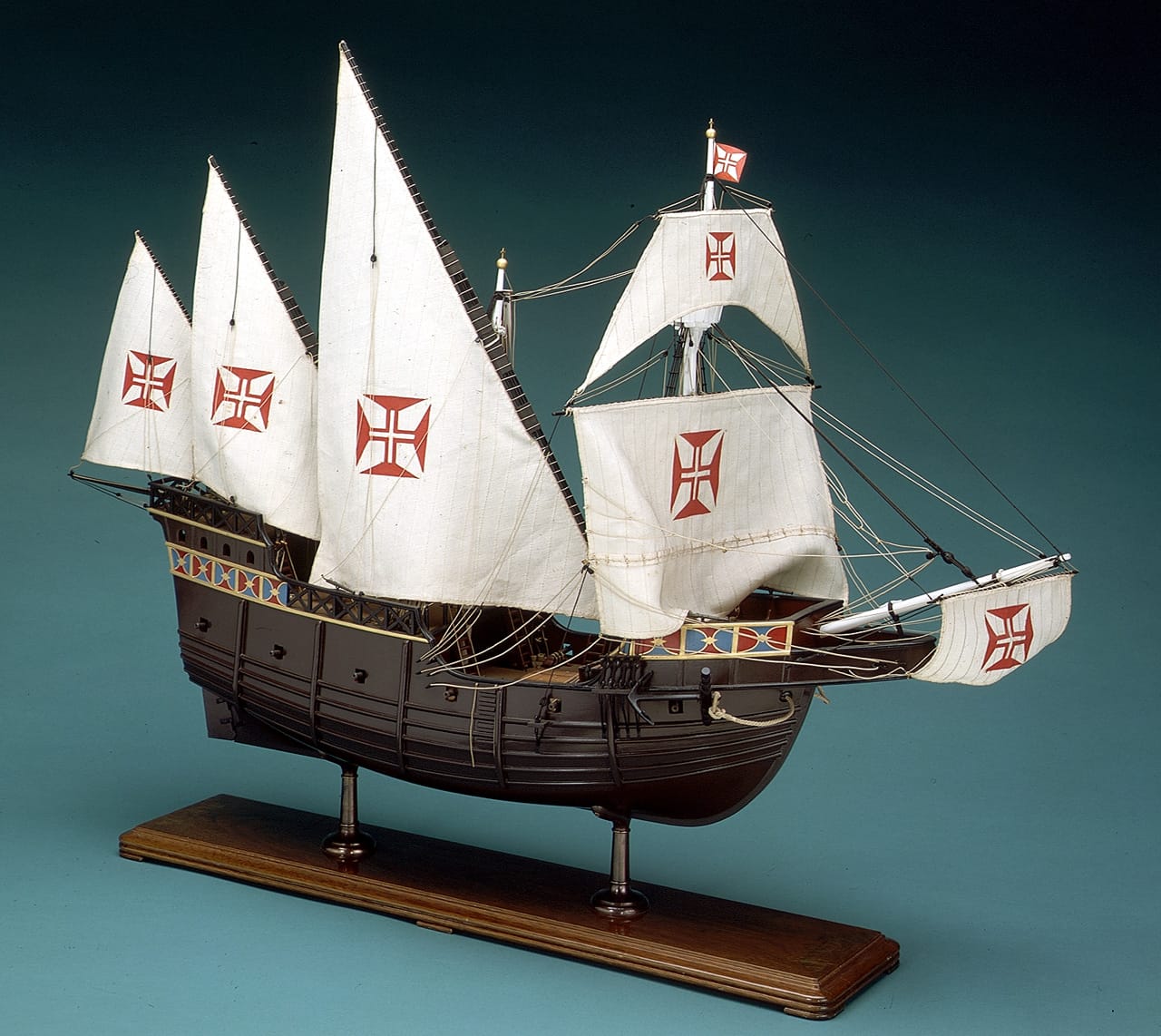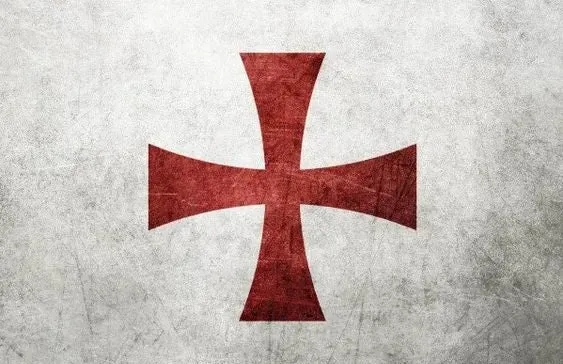Introduction
Living in Portugal, surrounded by castles and ruins, it’s impossible not to be struck by the legacy of the Templars and the other great military order, the Order of Aviz. Their scale, their influence, and their role in shaping the medieval world are nothing short of epic.
Portugal alone holds more than a hundred castles and fortifications. Many in the region known as the Beira “the edge”, itself divided into three parts: Beira Alta (Upper Edge), Beira Baixa (Lower Edge), and Beira Litoral (Coastal Edge). This frontier land lies between two great rivers: the Douro in the north, where Porto (once Portus Cale) guards its mouth on the Atlantic, and the Tagus in the south, where Lisbon commands the northern bank of its vast estuary.
For centuries, the vast area in between was a battlefield, a no man’s land where kings, warlords, crusaders, and Saracens clashed from the 11th to the 13th century. It is where the heart of Portugal was forged.
I live in central Portugal today, and I’ve walked among many of these extraordinary castles. Some were built by kings, others by knightly orders, often utilizing Roman foundations or even earlier ruins of Phoenicians and Carthaginians. Today the region is quiet: mountains, valleys, and olive trees, where ancient fortresses keep watch over villages of only a few hundred. Some, like Monsanto, have become film sets for series such as House of the Dragon. Others, like Idanha-a-Velha, were once bustling Roman cities, now reduced to peaceful little villages.
The Beira is more than history, it is also the inspiration for the setting of my game, Crónica. Because the Templars were so central to Portugal’s survival and identity, and equally central to my own creative work, I want to share the Portugal’s Templar history.
Templars & Portugal
When most people think of the Templars, they imagine the Crusades in the Holy Land. Yet their most enduring legacy may not lie in Jerusalem, but in Iberia. Without them, there might not be a Portugal today.
The Templars were more than crusaders, they were guardians in Iberia. They fought alongside Afonso Henriques to carve out Portugal’s independence, defended its borders for centuries, and safeguarded the royal line during succession crises. Their castles became the backbone of the kingdom, while their legacy of engineering, navigation, and cartography carried forward into the Age of Discovery.
Much of this survival was thanks to Portugal’s kings. Afonso Henriques, who granted them lands and castles, and Dinis, who protected them when no one else would, ensured the Order endured. Where other kingdoms betrayed or destroyed the Templars, Portugal embraced them, transforming them into the Order of Christ, which lasted for centuries (19th century)
This is not just the story of the Templars.
It is the story of Portugal itself.
Timeline of Key Events
- 1119 — Birth of the Templars
In the aftermath of the First Crusade, Hugues de Payens and Godfrey de Saint-Omer dedicate themselves to protecting pilgrims on the road from Jaffa to Jerusalem. King Baldwin II grants them quarters on the Temple Mount. They become the Pauperes commilitones Christi Templique Salomonici: the Poor Fellow-Soldiers of Christ and of the Temple of Solomon — soon known simply as the Knights Templar. - 1120s — Arrival in Iberia
The Templars reach Iberia during the height of the Reconquista. They prove indispensable not only as warriors, but also as engineers, logisticians, and protectors of pilgrims. They forge close alliances with the kings of León, Castile, and Aragon. - 1128 — First Templar castle in Portugal (Soure)
Donated by Teresa of León, mother of Afonso Henriques, the future first king of Portugal. This marked the beginning of the Templars’ presence in the kingdom, decades before Tomar. - 1129 — Recognition by the Church
At the Council of Troyes in France, the Templars are officially recognized. With guidance from St. Bernard of Clairvaux, their Rule is shaped, granting legitimacy and fueling recruitment across Europe. - 1139 — Battle of Ourique
Afonso Henriques, with the aid of the Templars, defeats the Moors. He is proclaimed King of Portugal (Rex Portugallensis), the legendary founding of the Portuguese monarchy. - 1140s–1190 — The “Stone Belt” of the Beira Baixa
King Afonso I grants the Templars vast lands and castles across central Portugal, realizing their role in defending the young kingdom. Fortresses like Monsanto and Castelo Branco become keystones of survival. - 1189–1190 — Siege of Tomar
The Almohad caliph Yaʿqūb al-Mansūr besieges Tomar with overwhelming force. Vastly outnumbered, the Templars hold firm. The defense becomes legend, and Tomar remains the heart of the Templars in Iberia. - 1190s–1240s — Frontier battles on the Tagus and in the Beira Baixa
The Templars defend a chain of fortresses; Tomar, Almourol, Pombal, and others against Almohad incursions, steadily pushing Portugal’s frontier south of the Tagus. - 1211 — Founding of the Order of Aviz
Formally recognized as a separate Portuguese order. Together with the Templars, they become a powerful force in the reconquest south of the Tagus. - 1249–1250 — Completion of the Reconquest
Portugal conquers the Algarve, reaching its modern southern frontier. Moorish power in Portugal is extinguished. - 1307 — Arrest of the Templars in France
King Philip IV of France arrests the Templars, branding them heretics. In Portugal, however, King Dinis shields them and preserves their estates. - 1311–1312 — Dissolution of the Templars
At the Council of Vienne, Pope Clement V formally dissolves the Order of the Temple throughout Christendom. - 1314 — Execution of the Grand Master
Jacques de Molay, last Grand Master of the Templars, is burned at the stake in Paris. - 1317 — Foundation of the Order of Christ
King Dinis reorganizes the Templars’ properties and men into a new institution, laying the groundwork for the Order of Christ. - 1319 — Papal recognition of the Order of Christ
By the bull Ad ea ex quibus, Pope John XXII officially recognizes the Military Order of Christ in Portugal. Its first master is D. Gil Martins, with headquarters at Castro Marim. - 1357 — Tomar restored as headquarters
The Order of Christ moves its seat to Tomar, the old Templar stronghold, which becomes its permanent center. - 1383–1385 — Succession Crisis
After the death of King Ferdinand I, Castile presses a claim to Portugal’s throne. The Orders of Aviz and Christ rally to maintain unity and independence. - 1385 — João, Master of Aviz, becomes King
The illegitimate son of Pedro I rises to lead Portugal. With the support of the people, nobility, and military orders, he defeats Castile at the Battle of Aljubarrota and becomes King John I, founding the Aviz Dynasty. - 15th century — Prince Henry the Navigator
As Grand Master of the Order of Christ, he channels the Order’s wealth into shipbuilding, navigation, and exploration. The Templar legacy fuels Portugal’s Age of Discovery. - 18th century — Orders reformed
The Orders of Christ and Aviz are transformed into honorific orders of merit under the Crown. - 20th century (1910 onward) — Survival as state honors
The Portuguese Republic retains the Order of Christ as a state honor, while the papal version falls dormant after 1987.
The Order of Aviz
While the Templars, later reborn as the Order of Christ, gained fame and legend, an equally vital brotherhood rose alongside them. These knights fought shoulder to shoulder with the Templars, spilling blood on the battlefield, defending kings, and ultimately safeguarding the very bloodline of the Portuguese throne.
The Order of Aviz was forged in the battles of the Reconquista. In 1165, the frontier raider Gerald the Fearless (Geraldo Sem Pavor) stormed and seized the Moorish stronghold of Évora. The victory was stunning, but without defenders, the city would fall back into enemy hands.
King Afonso Henriques, Portugal’s first monarch, entrusted Évora’s defense to knights of the Castilian Order of Calatrava. From their new base they fought relentlessly against Moorish counter-attacks, proving themselves not only as warriors but as steadfast guardians of the frontier.
Over the decades their presence grew. In 1211, they were formally recognized as a separate Portuguese brotherhood with their own convent at Avis in the Alentejo. From then on, they were known as the Order of Aviz, bearing the green cross flory as their symbol.
From their seat at Avis, the knights established a chain of fortresses across the Alentejo, securing the realm south of the Tagus. Meanwhile, their brother order, the Order of Christ, heirs of the Templars, held the castles of the Beira Baixa and the Tagus frontier to the north.
Together, the red cross of Christ and the green cross of Aviz became the twin pillars of Portugal’s defense. In the kingdom’s most perilous centuries, they stood united, anchoring its borders, protecting its monarchs, and laying the foundations of an independent Portugal.
Suppression and Survival
For centuries the Templars had been indispensable in Iberia, fighting shoulder to shoulder with the kings of Portugal, Castile, León, and Aragon. They built fortresses, manned frontiers, and shed blood in the Reconquista. Their castles anchored the borders and they fought to secure kingdoms.
But in France, their role was very different. There they had become bankers to kings, a vast financial institution lending sums so enormous that monarchs could never repay. Both King Philip III and his son, King Philip IV of France, borrowed heavily from the Templars. By the early 1300s, the crown was drowning in debt, and the Order was its creditor.
At the same time, the French monarchy tightened its grip on the papacy. Beginning in the 1280s, French kings consistently secured the election of compliant popes. The corruption was blatant. Pope Martin IV, under the influence of Charles I of Naples and his nephew, Philip III of France, declared a crusade not against Muslims, but against a fellow Christian, the King of Aragon. It remains the only papal crusade ever called against a Christian monarch, and it was not forgotten by the Iberian kings. Eventually, Pope Clement V, a Frenchman, abandoned Rome for Avignon. The so-called “Avignon Popes” came to be viewed as little more than vassals of the French crown.
Philip IV of France, desperate and ruthless, found his solution in destruction. If he could not repay the Templars, he would erase them. With Clement V at his side, he branded the Order heretics. The charges were monstrous: blasphemy, sodomy, idol worship, and secret rites whispered in shadows. But their true crime was independence. The Templars were rich, disciplined, and beholden to no king. They were allied with Iberia, not France. And for that, they had to die.
The hammer fell at the Council of Vienne (1311–1312). Clement V dissolved the Order of the Temple across Christendom. What followed was a purge. Templars were dragged from their commanderies, tortured into confessions, stripped of lands, and burned alive. In Paris, Grand Master Jacques de Molay was burned at the stake in 1314 (Friday the 13th), cursing king and pope alike with his last breath. King Philip IV dies within a year. France had killed the Templars.
The kings of Iberia remembered too well what the Templars had given them, fortresses, victories over Moorish armies, frontiers held against impossible odds. King Dinis of Portugal refused to betray them. He argued that in the Kingdom of Portugal the Templars were loyal, honorable, and essential. Instead of annihilation, he offered sanctuary. Many templars fled to the Kingdom of Portugal. In 1317, he quietly transformed their men and their castles into a new brotherhood: the Order of Christ.
In neighboring Aragon, King James II chose the same path, creating the Order of Montesa to preserve their mission and lands.
Thus, while the Templars were hunted down and exterminated in France and much of Europe, in Iberia they endured. In Portugal especially, their survival not only safeguarded the kingdom but endured for centuries.
Foundation of the Order of Christ
Pope John XXII formally established the Order of Christ in 1319 through the bull Ad ea ex quibus.
- First Seat: Castro Marim, fortress on the Guadiana River.
- First Master: D. Gil Martins, a former knight of the Order of Aviz.
- Rule: A modified Cistercian rule, under Alcobaça monastery.
In 1357, the headquarters moved to Tomar, where the old Templar convent and castle became once again the heart of a military order that would last for centuries.
The Orders and the Birth of a Dynasty
The Order of Christ, heir to the Templar legacy, did more than defend Portugal’s borders. It quietly helped shape the royal line itself.
In the mid-14th century, the Master of the Order of Christ advised King Pedro I (r. 1357–1367) to entrust his illegitimate son, João (John), to the care of the Order of Aviz. Raised and trained among its knights, João absorbed their discipline and values. When he came of age, he was elected Master of Aviz.
When the House of Burgundy, Portugal’s first royal dynasty, ended with the death of King Ferdinand I in 1383, the kingdom faced disaster. With no male heir, Castile pressed its claim to Portugal’s throne through dynastic marriage. For two years the nation teetered on the edge of annexation.
But João of Aviz rose to the challenge. Backed by the nobility, the people, and the military orders, he became the figurehead of resistance. In 1385, his forces crushed the Castilian army at the Battle of Aljubarrota, a victory that secured Portugal’s independence. In triumph, João was acclaimed King John I, founding the Aviz Dynasty, which would rule Portugal for nearly two centuries.
Through foresight, loyalty, and the martial training of their knights, the Order of Christ and the Order of Aviz not only preserved Portugal’s independence, they safeguarded its very lineage. Without them, the kingdom itself might have vanished into Castile, and later Spain.
Crosses and Colors

Each order carried its own symbol:
Order of Christ - a bold red cross, derived from the old Templar cross. This became emblazoned on the sails of Portuguese ships during the Age of Discoveries.
Order of Aviz - a green cross flory, distinctive in shape, often associated with the Aviz dynasty’s legitimacy.
Some historians argue that the modern flag of Portugal carries echoes of this heritage:
- the larger red field symbolizing the Order of Christ (successor to the Templars),
- the smaller green field recalling the Order of Aviz (which gave Portugal its ruling dynasty after 1385).
Whether by design or coincidence, the colors have become a poetic reminder for the enduring power of these two orders in Portuguese identity.
Fortresses and Seats of Power
Templar / Order of Christ Castles and Commanderies
- Tomar — Founded by Gualdim Pais in 1160; the Templar headquarters in Portugal until 1312. Became the headquarters for the Order of Christ in 1357.
- Castro Marim — First headquarters of the Order of Christ (1319–1357), guarding the Algarve frontier until Tomar was restored to prominence.
- Pombal — Early Templar frontier fortress (donated 1159), defending the road between Coimbra and Santarém.
- Dornes — Famous for its unusual round (later pentagonal) tower overlooking the Zêzere River.
- Almourol — Iconic Templar stronghold perched on a small island in the Tagus, symbol of their river defense system.
- Cardiga — A fortified commandery on the Tagus near the Zêzere mouth (granted 1169), supplying Tomar and Almourol with grain, wine, and horses.
The “Stone Belt” — Eastern Frontier (Beira Baixa / Ponsul Line)
- Castelo Branco — Major Templar commandery and fortified town.
- Idanha-a-Velha — Built atop the Roman Egitânia; a key stronghold on the frontier.
- Monsanto — Granite fortress, famed as “the most Portuguese village.”
- Penha Garcia — Overlooking the Ponsul valley, strategic outpost east of Monsanto.
- Segura — Castle guarding a major Tagus/Ponsul crossing into Castile.
- Ródão (Vila Velha de Ródão) — Fortress controlling the Tagus gorge.
- Castelo Novo — Templar fortress later incorporated into the border defense system of the Beira.
Other Templar Castles
- Soure — One of the earliest Templar castles in Portugal (donated 1128, even before Tomar).
- Longroiva — Strategic fortress in the Douro valley.
- Mogadouro — Northeastern fortress near the frontier with León.
Order of Aviz Castles and Commanderies
- Avis — mother house and convent (from 1211).
- Évora — original base of the order (late 12th century).
- Moura, Alandroal, Juromenha, Vila Viçosa, Alegrete, Monforte, Sousel — major Aviz fortresses across the Alentejo frontier.
- Alter do Chão & Fronteira — strongholds tied to Aviz commanderies.

Age of Discovery
More Than Warrior Monks
The Templars in Portugal were never just warriors. They were:
- Engineers, raising castles, bridges, and fortifications that still dominate the landscape.
- Shipbuilders and sailors, active along the Tagus and Atlantic coasts.
- Navigators and cartographers, preserving and expanding precious geographical knowledge.
- Administrators and bankers, masters of organization, logistics, and resources.
When the Order of the Temple was dissolved elsewhere in Europe, King Dinis ensured their knowledge and wealth survived in Portugal by transferring them into the Order of Christ. This act preserved centuries of expertise in engineering, shipbuilding, navigation, and cartography and set the stage for Portugal’s golden age.
In the 15th century, Prince Henry the Navigator (1394–1460), as Grand Master of the Order of Christ, channeled that legacy into the sea. The Order’s immense resources funded voyages along Africa and into the Atlantic, while their knowledge guided Portugal into uncharted waters. The red cross of the Order of Christ, inherited from the Templars, flew proudly on the sails of caravels from Africa to Asia, the symbol of a medieval order reborn as the driving force of the Age of Discovery.
Why They Mattered
Without the Templars, later reborn as the Order of Christ, and the Order of Aviz, the Kingdom of Portugal might never have survived.
They stood beside Afonso Henriques at the birth of the nation. From the 11th to the 13th centuries, these orders were the backbone of the realm:
- Building and garrisoning frontier fortresses along the Tagus, Zêzere, and Ponsul.
- Fighting shoulder to shoulder with kings in the Reconquista.
- Resettling and securing newly won lands.
- Providing a disciplined military elite to a kingdom often outnumbered by its enemies.
When the Templars were dissolved across Europe in 1317, King Dinis preserved them in Portugal by transforming their brotherhood into the Order of Christ. In doing so, he safeguarded not just their estates but their unmatched mastery of shipbuilding, navigation, cartography, and engineering, knowledge that, a century later, would launch the caravels of the Age of Discovery.
In 1385, their unity crowned João, Master of Aviz, as king, saving Portugal’s independence at Aljubarrota. Their red and green crosses defended not only the kingdom but came to embody its very identity, a legacy some believe still echoes in the modern Portuguese flag.
The Orders of Christ and Aviz bled for Portugal: for its people, its crown, and its survival. Without them, there might be no Portugal at all. And without Portugal, the wider world might look very different.
The Templars are remembered for Jerusalem. But it was in Iberia that they secured kingdoms, forged nations, and explored the oceans.


Member discussion: